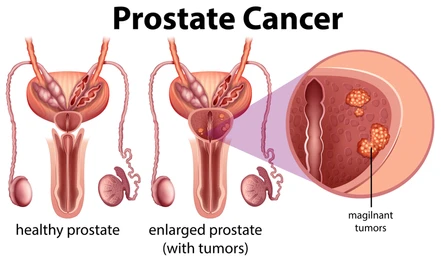Prostate Cancer Stages and Survival Rates
Prostate cancer is a topic of Great Concern for Many individuals, especially in India, where the incidence of this disease is rising. In this blog, we embark on a journey through the intricate landscape of prostate cancer survival rates.
We’ll delve into the significance of these rates, offering the latest statistics and shedding light on the multitude of factors that influence a patient’s prognosis.
With insights from Dr. Bhushan Zade, a distinguished Prostate Cancer Specialist in Pune, we’ll not only explore the different stages of prostate cancer but also uncover the profound impact they have on survival rates.
Additionally, we’ll touch upon the costs associated with treatment, the ever-evolving landscape of research advancements, and provide invaluable guidance for individuals in search of the best treatment options. Your quest for knowledge and informed decisions begins here.
Understanding Prostate Cancer Survival Rates
Prostate cancer survival rates refer to the percentage of individuals who survive the disease for a certain period after diagnosis. These rates are typically presented as a five-year survival rate, which indicates the percentage of individuals still alive five years after being diagnosed with Prostate Cancer.
It’s important to note that survival rates are estimates based on large groups of people and may not accurately predict an individual’s prognosis. Each person’s case is unique, and survival rates can vary depending on various factors.
Prostate Cancer Survival Rate Statistics in India
In India, prostate cancer is the second most common cancer among men, with an increasing incidence rate. According to the Indian Council of Medical Research (ICMR), it is estimated that there will be around 35,000 new cases of prostate cancer annually by 2025. The survival rates for prostate cancer have shown improvement in recent years due to advancements in early detection and treatment.
According to the latest data, the five-year survival rate for prostate cancer in India is approximately 80%. However, it’s important to remember that these statistics are general figures and may vary based on individual factors such as age, overall health, stage at diagnosis, and treatment received.

Factors Affecting Prostate Cancer Survival Rate
Several factors can influence prostate cancer survival rates. The cancer stage at diagnosis plays a crucial role in determining prognosis. Generally, prostate cancer is divided into four stages:
- Localised Prostate Cancer: Cancer is confined to the prostate gland and has not spread to other body parts. The five-year survival rate for localised prostate cancer is high, with approximately 99% of individuals surviving beyond five years.
- Locally Advanced Prostate Cancer: Cancer has spread beyond the prostate gland to nearby tissues or lymph nodes. The five-year survival rate for locally advanced prostate cancer ranges from 70% to 90%.
- Regionally Advanced Prostate Cancer: Cancer has spread to nearby organs or tissues, such as the bladder or rectum. The five-year survival rate for regionally advanced prostate cancer is around 30% to 50%.
- Metastatic Prostate Cancer: Cancer has spread to distant bodily sites, such as the bones, liver, or lungs. The five-year survival rate for metastatic prostate cancer is approximately 10% to 30%.
Other factors, such as the tumour’s grade, the patient’s age, and overall health, also impact survival rates. Early detection through regular screenings can improve survival rates by allowing timely treatment.
Prostate Cancer Treatment Options
Treatment Options for Prostate Cancer in India Include:
- Surgery: Surgical options include radical prostatectomy, which involves the removal of the prostate gland, and minimally invasive procedures such as robotic-assisted laparoscopic prostatectomy.
- Radiation Therapy: This treatment uses high-energy rays to kill cancer cells. It can be delivered externally (external beam radiation therapy) or internally (brachytherapy).
- Hormone Therapy: Also known as androgen deprivation therapy, this treatment aims to reduce the levels of male hormones (androgens) that promote the growth of prostate cancer cells.
- Active Surveillance: In cases where the cancer is low-risk and slow-growing, active surveillance involves close monitoring of the cancer without immediate treatment.
Treatment choice depends on several factors, including the cancer stage, the tumour’s aggressiveness, and the patient’s overall health. Treatment plans are personalised to meet the specific needs of each individual. It’s essential to have open and honest discussions with your doctor to understand each treatment option’s potential benefits and risks.

Prostate Cancer Stages and Survival Rates
As mentioned earlier, the stage at diagnosis plays a crucial role in determining the treatment approach and the chances of long-term survival. Generally, localised prostate cancer has higher survival rates compared to advanced stages. Early detection through regular screenings increases the likelihood of catching the cancer at an early stage when treatment is most effective. It’s recommended that men aged 50 and above, or those with a higher risk due to family history or other factors, undergo regular screenings for prostate cancer.
Prostate cancer progresses through different stages, each indicating the extent and severity of the disease. want to know which is the The Four primary stages of Prostate cancer Click on the link.
Prostate Cancer Treatment Costs in India
The cost of prostate cancer treatment in India can vary depending on the type of treatment, hospital facilities, and additional medical services required. It is advisable to have health insurance coverage that includes cancer treatment to alleviate the financial burden. Additionally, government schemes and nonprofit organisations provide financial assistance and support to individuals undergoing cancer treatment.
It’s essential to consider the overall cost of treatment, including pre-operative tests, surgery or radiation therapy, post-operative care, medications, follow-up visits, and potential side effects management. Discussing the estimated costs with a surgeon and exploring available resources can help you plan for the financial aspect of prostate cancer treatment.
Advancements in Prostate Cancer Research
Prostate cancer research advancements have been made, leading to improved treatment options and outcomes. Researchers are constantly exploring new therapies, targeted treatments, and precision medicine approaches to manage prostate cancer better. Advancements in imaging techniques, such as multiparametric MRI, have enhanced the accuracy of prostate cancer diagnosis and staging.
Immunotherapy, which harnesses the body’s immune system to fight cancer cells, has shown promise in treating advanced prostate cancer. Precision medicine, based on genetic profiling of tumours, allows for personalised treatment approaches that target specific genetic alterations.
Clinical trials are also ongoing, offering potential access to innovative treatment options for eligible patients. Participating in clinical trials can not only provide access to cutting-edge treatments but also contribute to the advancement of prostate cancer research.
Best Treatment Options for Prostate Cancer in India
Choosing the best treatment option for prostate cancer is a decision that should be made in consultation with a surgeon. Factors such as the cancer stage, overall health, and individual preferences should be considered. It is essential to have a comprehensive understanding of each treatment option’s potential benefits, risks, and side effects.
Recently, a shift has been made towards personalised medicine in prostate cancer treatment. This approach considers the unique characteristics of each patient’s tumour and tailors treatment accordingly. For example, some patients may benefit from surgery, while others may be better suited for radiation therapy or a combination of treatments.
Active surveillance may be recommended for individuals with low-risk, slow-growing tumours to avoid unnecessary treatment and its associated side effects. Hormone therapy is often combined with other treatments to improve outcomes in advanced cases.
It’s crucial to have open and honest communication with a surgeon, ask questions, and seek a second opinion if needed. The decision-making process should consider the medical aspects, quality of life, potential side effects, and long-term prognosis.
Conclusion
Understanding prostate cancer survival rates is crucial for individuals and their loved ones facing a cancer diagnosis. While survival rates provide a general outlook, it’s important to remember that each case is unique. Regular screenings, early detection, and timely treatment significantly improve the chances of successful outcomes.
It is essential to prioritise awareness and education about prostate cancer among the Indian population. By staying informed and taking proactive steps, individuals in India can navigate the challenges of prostate cancer with confidence and hope. Remember, this blog provides general information and should not replace professional medical advice. Always consult a surgeon for accurate diagnosis, personalised treatment plans, and guidance tailored to your situation.

